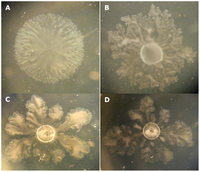Beijerinckia derxii: Difference between revisions
| Line 6: | Line 6: | ||
Bacteria; Proteobacteria; Alphaproteobacteria; Rhizobiales; Beijerinckiaceae; Beijerinckia; Beijerinckia derxii | Bacteria; Proteobacteria; Alphaproteobacteria; Rhizobiales; Beijerinckiaceae; Beijerinckia; Beijerinckia derxii | ||
[[File:File.png|200px|thumb|left|Enrichment culture of <i>Beijerinckia</i> Inoculated with tropical soil. Demonstrates viscosity and slime production after 3 weeks. Bar=1 cm]] | |||
Revision as of 16:13, 26 April 2010
Beijerinckia derxii
Classification
Higher order taxa
Bacteria; Proteobacteria; Alphaproteobacteria; Rhizobiales; Beijerinckiaceae; Beijerinckia; Beijerinckia derxii
NCBI: Taxonomy
|}
Description and significance
A unicellular organism. Free-living (non-symbiotic), Aerobic, chemoheterotrophic bacteria with N2 fixing capabilities. Rod-shaped when young; pear, or dumbbell shaped cells with aging; polar lipoid bodies on each end of the cell. These bacteria are extremely acid tolerant and have been shown to fix more nitrogen as the acidity levels increase (down to 2.7 pH) (Barbosa et. all. 2002) The microbe is more prominent in acidic soils yet is often found in alkali soils as well.
Being found in almost every soil on Earth, this bacteria plays important roles in plant-growth due to its metabolism. It can survive cold weather, making it ideal for temperate regions that experience a seasonal freeze. It produces a slime that makes it easier for water retention in rainforest soils. It also is a provider of fixed N2 from the atmosphere. The pigments it secretes may be important in the stimulation of other microbes in the surrounding environment.
Circular DNA structure similar to other bacteria. The exact 16srRNA sequence is as follows: http://www.ncbi.nlm.nih.gov/nuccore/47457723
Cell structure and metabolism
The cell is rod-shaped. They generally range from 1.7-4.5μm in length and about .5-1.5 μm in diameter. Beijerinckia derxii is generally smaller than Azotobacter. The temperature range is from 10° to 35° C.
They contain two lipoid structures at the polar ends of the cell. These structures are highly refractile and may be involved with light protection. These lipoids consist of poly-β-hydroxybutyrate (PHB).
It has the ability to turn a liquid media viscous by polysaccharide slime production. On surface media they produce raised colonies of highly elastic slime in varying colors. B. derxii can be characterized by a green fluorescent pigment, this pigment is most prominent on iron-deficient media.
The exopolysaccharides may also protect the nitrogenase from oxygen damage, as it forms a protective O2 barrier.
Low O2 availability increases the production of nitrogenase, similar increases were seen in the presence of thoisulfate and in a low pH (2.7) (Barbosa et. all. 2002)
Similarly, low levels of carbohydrates produce the same effect.
Carbon utilized includes a large array of sugars, organic alcohols, and organic acids. They can also hydrolyze starches. They have been shown in alkali medium to decrease the pH to about 4.0-5.0; this is accomplished by acetic acid and some lactic acid production (Becking 1961). They require molybdenum in their nitrogen fixation and for optimal growth. CaCO3, a necessary mineral in most Azotobacter species, inhibits the lag phase of growth in Beijerinckia.
Ecology
Initially isolated from a Malaysian quartzite soil by Altson in 1936; and again in Australia by Tchan in 1957 It can withstand very acidic conditions. This microbe has also been isolated from Europe, South America, Continental Asia, China, Japan, Australia, and Pacific Northwest Soils in the Americas. Suggesting that the microbe has world-wide distribution. It has been shown to resist freezing and the strands are viable indefinitely when frozen in liquid nitrogen. No reduction of viability occurs when stored for 3-4 months at -4° C. (Becking, 1961)
It has also been studied how B. derxii is able to stimulate plant growth as well as other plant responses with releasing certain plant growth regulators, specifically indoleacetic acid (IAA), ethylene, polyamines, and certain amino acids into the soil.(Thuler et.all 2003)
It has been shown that within the Rhizosphere of rice plants, Beijerinckia numbers increase. No evaluation has yet been made to this phenomenon. Similar occurrences have been reported in sugar cane soils. One experiment demonstrated that sorghum strongly stimulates the growth of Beijerinckia.
Apart from being within soil and water habitats, Beijerinckia have also been isolates within both the rhizosphere and the phyllosphere of plants. There is no evidence to suggest that the nitrogen fixed by this microbe benefits the plants' growth.
References
Becking J.H. Nitrogen Fixing bacteria of the genus Beijerinckia. Soil Science 118. p196-212.
Bergey's Manual of Determinative Bacteriology, 9th ed. Edited by John G. Holt et al. Baltimore: Williams & Wilkins, 1994.
Heloiza R. Barbosa; Marcos A Moretti; Daniela S. Thuler; Elisabeth F.P. Augusto. Nitrogenase activity of Beijerinckia Derxii is preserved under adverse conditions for its growth. Brazilian Journal of Microbiology. São Paulo. Vol.33 no.3. July/Sept. 2002
Heloiza R. Barbosa; Deliela S. Thuler; Márcia A. Shirakawa; Natália R.S. Miyasaka. Beijerinckia Derxii stimulates the viability of non-n2-fixing bacteria in nitrogen-free media. Brazilian Journal of Microbiology. São Paulo. Vol.31 no3. July/Sept 2000
Jan Hendrik Becking. The Genus Beijerinckia. Prokaryotes 5. p151-162. 2006
Daniela S. Thuler; E.L. Floh; W. Handro; Heloiza R. Barbosa. Beijerinckia derxii releases plant growth regulators and amino acids in synthetic media independent of nitrogenase activity. Journal of Applied Microbiology. 2003. Vol.95. no.4. p799-806.

